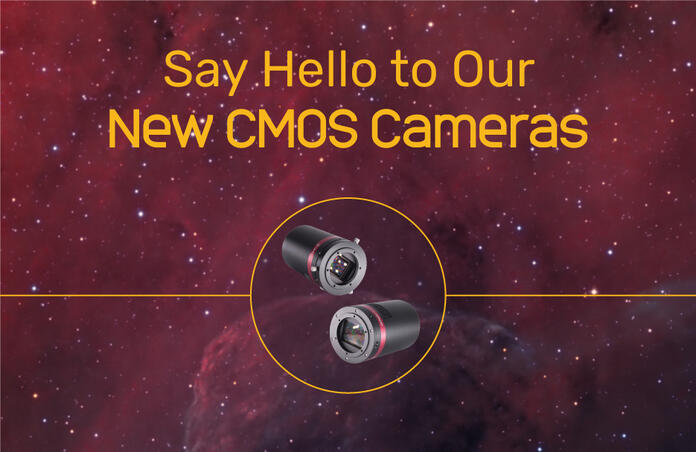Say Hello to Our New CMOS Cameras

As most people will be well aware, Telescope Live strives to provide the best quality astrophotography equipment to our members.
It’s part of our mission to make astrophotography more accessible, regardless of budget, location and ability level.
Needless to say, the cameras used on our telescopes are a key part of that.
In this post, we’ll discuss our move from CCD cameras to CMOS – including the differences, advantages, specifications and timeframes.
But, before that, allow us to tell you that, due to the installation of the new CMOS cameras on our network, some of our telescopes might be offline for some days (meaning there will also be a temporary shortage in the acquisition of new One-Click Observations - but just for a few days)
An introduction to CCD and CMOS cameras
Up until recently, the best cameras for astrophotography were high-end CCD cameras. That stands for charge-coupled device – referring to the circuit used to capture images, which converts photons to electrons.
In the last few years, new sensors have been made available. They use a different technology, called CMOS – Complementary Metal Oxide Semiconductor. Like CCDs, they are a semiconductor that convert light into electrical signals.
However, they do so at a faster rate, and are even more energy efficient. You can find out more in Part 2 of our series on Astroimaging Basics made by the one and only Nik Szymanek.
Above all else, modern CMOS sensors provide best in class performance, and have practically replaced the ageing CCD technology. While some purists might argue that CCD are still better (and, in some very specific applications, this is true), the advantages in terms of performance offered by CMOS is unparalleled
Making the move to CMOS
At Telescope Live, we’ve only ever used the best CCD cameras that were commercially available – with very large sensors to ensure excellent performance.
However, even the best CCD chips age with time and lose their performance. Because we acquire images every clear night, our sensors are certainly no exception.
As such, we found ourselves at a point where many of our sensors needed to be replaced. Given the clear shift from CCD to CMOS, we’ve decided to transition and upgrade all our cameras to newer, best in class CMOS sensors.
We’ve partnered with QHY, choosing the QHY 600 monochromatic camera. This back-illuminated Scientific CMOS Camera is equipped with a Sony IMX455 and offers extremely low dark current, low readout noise, and exceptional resolution thanks to the small pixel size.
How the change will affect you
Clearly, such a change of technology will have some impact on our users; let’s see how this will affect your experience with the Telescope Live platform.
Combining images
While the move to CMOS has clear advantages for users, it also brings some practical changes to the platform. Firstly, you won’t be able to combine images acquired with CCD and CMOS cameras, even if the telescope is the same.
To ease the transition, we have renamed our telescopes – adding a suffix to the telescope name. For instance, CHI-1-CCD will refer to images acquired with CHI-1 using the old CCD, while CHI-1-CMOS will refer to images acquired with CHI-1 using the new CMOS cameras.
Observation Bundles will also be separated to images acquired with the CCD cameras and those acquired with CMOS. So, the same target observed with the same telescope will be divided into two separate bundles depending on the type of camera used.
Image size
Another difference comes in the size of images.
Our new CMOS cameras have a much smaller pixel size. This is great news as we can increase the resolution of our wide field of view telescopes massively. For instance, the plate scale of our Takahashi telescopes will decrease from 5 arcsec/px to 2 arcsec/px – more than doubling the final resolution of your images
But higher resolution comes at a cost. The image size will be much larger. A single image will be almost 120mb in size.
For longer focal length telescopes this isn’t much of a benefit. Increasing the resolution of the camera doesn’t actually increase the resolution of the final image, as we are limited by local the local seeing (the quality of the sky).
In this case, we will provide binned images, so that the effective pixel scale is coherent with the local sky conditions. This means that for longer focal length telescopes (such as CHI-1 and SPA-2), the final image size will be similar to the current image size (10-20mb per image, depending on the binning).
Advanced Requests
Another huge advantage of CMOS cameras is that they have virtually no overheads when you acquire images. CCD cameras tend to have very long overheads to readout and download the image from the chip, while CMOS transfers are instantaneous.
This means that we can be much more efficient, and can effectively reduce the costs of your observations, considering that our pricing for advanced requests is based on telescope utilisation. Take a look at our Advanced Request pricing model for more information.
When will the changes happen?
The advantages of CMOS are clear. So, when will you be able to reap the rewards of these new cameras?
The answer is now!
We have already started the process, and over the next few days, the new CMOS cameras will be installed on all of our telescopes in the northern and southern hemispheres.


